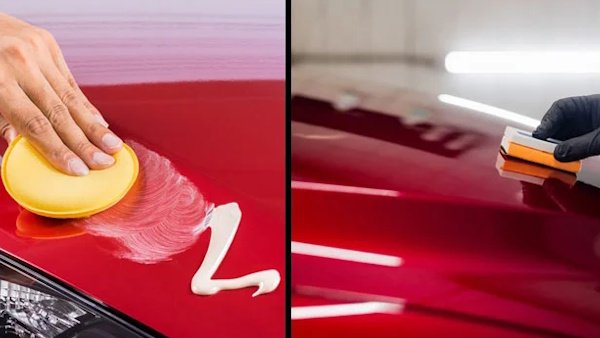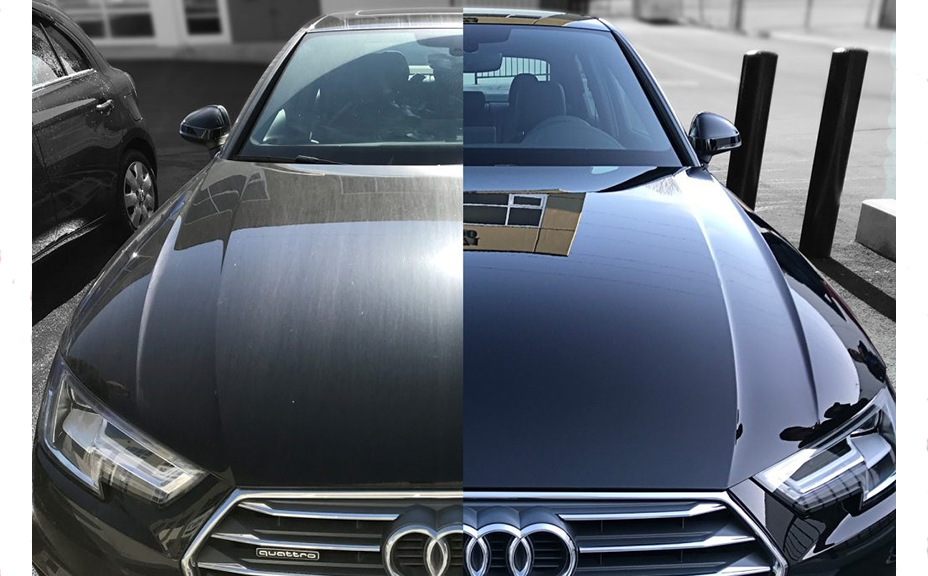A quick guide to arranging Ceramic Coating Newark professionally
Wiki Article
Discovering the Scientific Research Behind Car Ceramic Coating and Its Protective Qualities
The science of car ceramic coating presents a remarkable research in sophisticated automotive defense. Composed primarily of silicon dioxide and polymers, these layers develop a robust bond with car paint. This interaction improves durability against environmental risks while using hydrophobic advantages. Nonetheless, the intricacies of exactly how these finishes job and their lasting benefits continue to be much less comprehended. Unboxing these information reveals why ceramic coatings are becoming a recommended choice for vehicle treatmentWhat Is Ceramic Coating?
Ceramic coating is a liquid polymer that chemically bonds to the surface area of a car's paint. This innovative safety layer enhances longevity and provides exceptional resistance to ecological elements. Unlike standard wax or sealers, which give momentary security, ceramic coatings produce a lasting guard that can hold up against harsh conditions such as UV rays, acidic impurities, and severe weather. When applied properly, the coating develops a hydrophobic surface area, creating water to bead and slide off, which helps in preserving the vehicle's sanitation. Additionally, it uses improved gloss and depth to the paint, making the lorry show up more sleek and dynamic. The application procedure generally entails detailed surface preparation, including cleansing and polishing, to guarantee peak bonding. Because of this, ceramic finishes are coming to be significantly popular among car enthusiasts and those seeking to safeguard their investments, guaranteeing to keep the automobile's visual charm while minimizing the regularity of maintenance.The Structure of Ceramic Coatings
The detailed formulation of ceramic layers mostly is composed of silicon dioxide (SiO2), which is derived from all-natural resources like quartz and sand. This key element offers the structure for the coating's longevity and protective top qualities. Along with SiO2, ceramic coatings usually consist of various polymers and ingredients that enhance attachment, flexibility, and resistance to environmental elements. These compounds work synergistically to create a robust barrier against pollutants such as dust, chemicals, and UV rays.Furthermore, some formulations include titanium dioxide (TiO2) or other nanomaterials, which can boost the coating's hydrophobic buildings, causing enhanced water repellency. The precise composition can differ substantially amongst manufacturers, influencing performance and long life. Ultimately, the mix of these aspects finishes in a protective layer that not just enhances the visual appeal of lorries however additionally serves to lengthen their lifespan by securing the surface from prospective damage.Exactly How Ceramic Coatings Work
Understanding how ceramic coverings work involves discovering their chemical composition, which adds to their protective qualities. The application procedure is necessary for accomplishing suitable results, while long life and longevity aspects identify the coating's effectiveness over time. With each other, these aspects highlight the advantages and efficiency of ceramic coatings for car defense.Chemical Make-up Explained
While numerous car owners look for durable protection for their cars, the chemical structure of ceramic layers plays a vital duty in their effectiveness. These finishings largely include silicon dioxide (SiO2), which is acquired from natural minerals. This substance develops a strong bond with the lorry's paint, producing a durable, safety layer. Additionally, several ceramic coatings have titanium dioxide (TiO2), improving their hydrophobic residential or commercial properties and resistance to UV rays. The presence of polysiloxanes can additionally boost versatility and longevity. Together, these aspects add to the coating's ability to push back water, dirt, and impurities, while likewise providing a high-gloss coating. Comprehending this chemical structure aids car proprietors appreciate the durable security used by ceramic finishings.Application Refine Overview
Using ceramic coverings involves a meticulous procedure that guarantees perfect bonding and protection for the car's surface. Initially, thorough cleansing and purification of the car's outside are carried out to remove dust, gunk, and previous waxes. This step verifies that the surface is without pollutants that can prevent attachment. Following this, the paint is often polished to improve clearness and remove any imperfections. Once prepared, the ceramic coating is used in small areas utilizing an applicator pad, permitting for consistent coverage. The coating is after that left to treat, forming a solid chemical bond with the surface. Appropriate curing times and problems are critical, as they confirm the coating achieves its maximum performance and protective top qualities.Durability and Resilience Variables
Ceramic finishes are designed to offer resilient security with their sophisticated chemical structure, which creates a robust barrier against ecological pollutants. The sturdiness of these finishes is affected by aspects such as the density of the Clicking Here application, the high quality of the item, and the problems under which the lorry is subjected. Premium ceramic layers can last several years, withstanding scrapes, UV rays, and chemical stains. Appropriate upkeep, consisting of routine washing and regular reapplication, can better enhance long life. In addition, ecological aspects like climate and direct exposure to contaminants can affect the life expectancy of the coating. Generally, when used and kept properly, ceramic coverings supply outstanding sturdiness, making them a preferred option for car fanatics looking for to protect their automobile's look.Hydrophobic Features and Water Repellency
Hydrophobic residential properties are a trademark of high quality car ceramic finishes, significantly improving the automobile's surface performance. These finishes develop a molecular bond with the car's paint, resulting in a surface area that fends off water properly. When water enters call with a ceramic-coated surface, it beads up and rolls off, lessening the amount of liquid that continues to be on the paint. This behavior not just contributes to an aesthetically pleasing appearance however additionally lowers the buildup of contaminants such as dirt, crud, and roadway salts.The boosted water repellency causes simpler cleansing and upkeep, as less initiative is needed to remove undesirable compounds. Furthermore, the hydrophobic nature of ceramic layers aids in avoiding water spots, which can mar the finish of uncoated surfaces. Generally, the consolidation of hydrophobic properties in ceramic coverings plays a vital role in maintaining the vehicle's immaculate look while simplifying upkeep.Protection Versus Scratches and UV Damages
Car ceramic coverings provide considerable security against scratches and UV damages. The scratch resistance mechanism produces a durable layer that soaks up effects, while the UV shielding her explanation advantages help preserve the vehicle's paint honesty in time. Together, these attributes add to a longer-lasting and visually enticing coating.Scrape Resistance Device
Utilizing sophisticated modern technology, ceramic coatings give a durable shield against scrapes and UV damages, enhancing the long life and look of lorry surface areas. The scrape resistance device of these finishings is connected to their unique molecular structure, which develops a sturdy bond with the vehicle's paint. This bond produces a hard, safety layer that can take in impacts and withstand abrasions. Additionally, the smooth surface area of the coating reduces rubbing, making it hard for impurities to adhere and create scrapes. The chemical composition of ceramic layers often consists of nanoparticles that enhance the safety layer, additional enhancing its durability. As a result, lorries treated with ceramic coatings display significantly boosted scratch resistance contrasted to traditional wax or sealers, ensuring an excellent coating in time.UV Shielding Perks
The safety high qualities of ceramic finishings expand beyond scrape resistance to include substantial UV securing advantages. These coverings produce a durable barrier that reflects dangerous ultraviolet rays, safeguarding the car's paint and underlying materials. Prolonged exposure to UV radiation can bring about fading, oxidation, and degeneration of the paint surface. By incorporating ceramic finishings, automobile proprietors can properly alleviate these dangers, preserving the aesthetic charm and integrity of their cars. In addition, the UV obstructing homes contribute to enhanced durability, lowering the frequency of painting and upkeep. Ultimately, the integration of ceramic layers supplies a detailed solution for securing vehicles from the damaging results of sun direct exposure, making sure a continual, vivid look over time.The Long life and Maintenance of Ceramic Coatings

Frequently Asked Questions
Can Ceramic Coating Be Applied to Any Type Of Type of Car?
Ceramic coating can be related to numerous sorts of automobiles, consisting of cars, vehicles, and motorcycles. Surface area prep work and compatibility with certain products are crucial for excellent attachment and performance of the coating.How Much Does Ceramic Coating Generally Cost?
Ceramic coating typically sets you back in between $500 and $2,000, depending on variables such as lorry size, coating top quality, and expert application. The investment can give resilient protection and improve the car's look gradually.
Is Specialist Application Needed for Finest Results?
The need of specialist application commonly depends upon preferred results. Specialists normally guarantee proper surface area prep work and application strategies, leading to optimal bonding and durability of the coating, which may be challenging for inexperienced individuals to accomplish.Can Ceramic Coatings Be Removed or Fixed?
Ceramic coatings can be gotten rid of or fixed, though the process might require details solvents or methods - Ceramic Coating Newark. Proper elimination is vital to avoid webpage damages to the underlying surface, stressing the significance of specialist support for suitable resultsExactly How Does Porcelain Coating Compare to Conventional Wax?
The comparison in between ceramic coating and typical wax reveals that ceramic coatings supply superior durability, boosted protection versus ecological pollutants, and longer-lasting shine, while wax calls for much more constant application and supplies much less overall resistance to damages.Report this wiki page